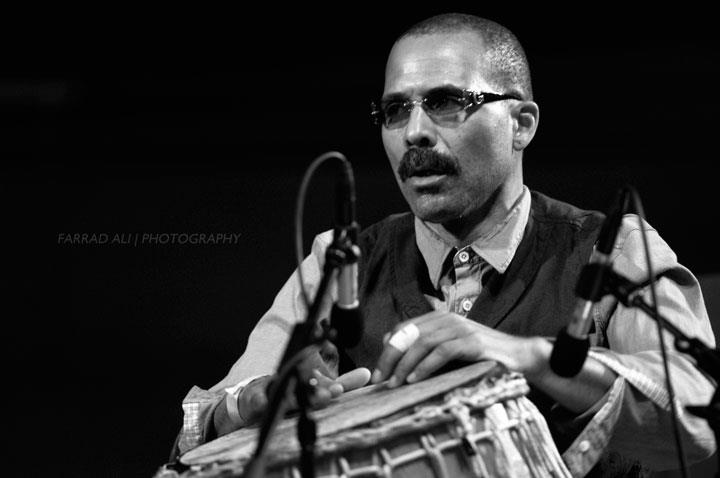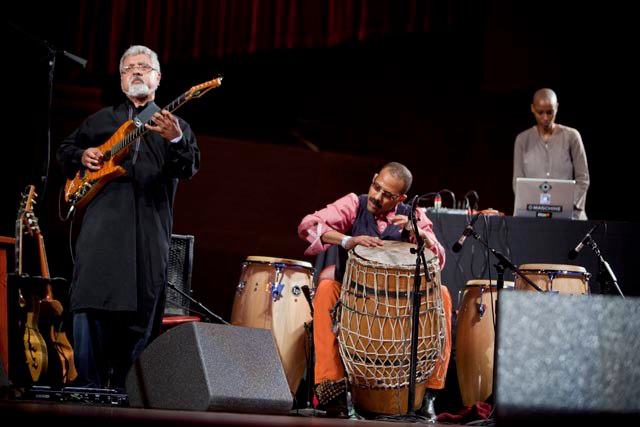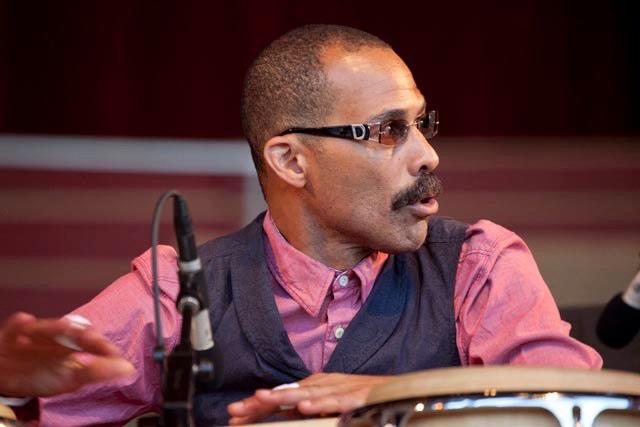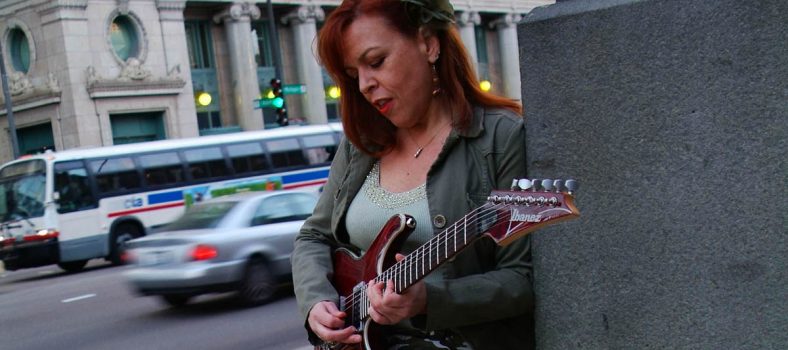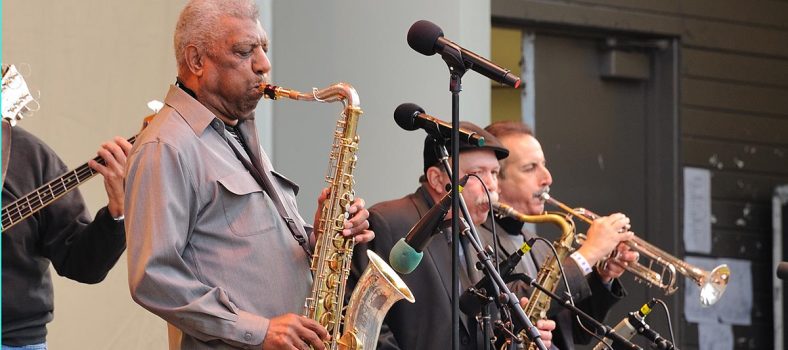Kahil El’Zabar has been playing music nearly all of his life. One could say that he was a musical prodigy who learned from music’s best in class. As a teenager, he was a professional jazz musician touring the world. Today, he continues performing around the world to audiences that know his music to be innovative and captivating. El’Zabar spoke exclusively with iRockJazz writer Angelique Westerfield about his musical development, experiences, and inspirations.
iRJ: When was the first time you attempted to play an instrument?
KEZ: Probably about when I was two years old.
iRJ: What instrument was it?
KEZ: Drums….drum kit.
iRJ: Who were your musical influences growing up as a child/ teenager?
KEZ: My uncle and my father were the first. They were both drummers. My uncle’s name is Candy Leroy Finch. He played with Charlie Parker, Dizzy Gillespie, and Fats Navarro, and many Be Bop giants. He was very well respected. He was my first hero. So, I started playing really consistently at about four years old.
iRJ: So it was your uncle who really attracted you to jazz?
KEZ: Yeah…you know jazz – until the 60s – was a very popular music. So, I grew up seeing Duke Ellington, Louis Armstrong, Dizzy Gillespie, and Sammy Davis Jr. who was a jazz singer and a tap dancer. Sammy Davis Jr. was as popular as Michael Jackson. So, I tap danced as a kid; studying with Tommy Sutton and Sammy Dyer. I went to jazz concerts with my parents and saw it on T.V.
iRJ: It wasn’t a distant attraction….you had it right there – live and in color. [what attracted you to jazz?]
KEZ: Right, and all these great jazz musicians lived right here in Chicago. You would see them all the time. My parents used to tell me who this person was, and it was revered in our community.
iRJ: In Chicago, what neighborhood did you grow up in?
KEZ: Englewood, then I moved to Chatham. Englewood until about ten, and then afterwards Chatham.
iRJ: You obviously were inspired to become a musician at an early age. At what point in your life did you decide to be a musician professionally?
KEZ: I went on the road with Gene Ammons – the great saxophonist – when I was sixteen.
iRJ: Did you formally train as a musician at a school?
KEZ: Yeah, school helped me with certain aspects of music – music theory, music composition, and harmony. Those are just basic skills. But my real skill was….when I was a teenager I was around cats like Cannonball Adderly, Dizzy Gillespie, Miles Davis…some of the greatest musicians in history. So they were my teachers, my peers, and my collaborators. Some of the greatest musicians came from the Academy of the Streets.
iRJ: That’s right….the Academy of Life.
KEZ: Yeah, at sixteen I graduated from high school, then went on tour. After traveling on the road for a year and a half with Gene Ammons and some other people, I wanted to go to school. I went to Lake Forest College. I did my undergrad there. I applied and received a full music scholarship. Then in 2006, I received my doctorate from Lake Forest in Interdisciplinary Arts. So, I’m also a PhD. So, I have the academic training, but I consider what I learned is really from my mentors… my true school of music.
iRJ: Right….who actually gets to experience and say that Miles Davis and Dizzy Gillespie were their teachers.
KEZ: I was very fortunate….very fortunate.
iRJ: You were granted an opportunity to study with the infamous mime artist – Marcel Marceau – in Paris. how did that come about?
KEZ: Lake Forest College had a on-going exchange program in Paris through their Theater and Performing Arts Department with the Marcel Marceau School of Pantomime. So, I was granted an exchange, and that’s where I was suppose to go. And I wrote to Professor Nana Nketia in Ghana, a very accomplished musicologist. And I asked him to invite me to Ghana, and then he did. It ended up costing the same thing as it would have to do the program in Paris. I already had been to Paris, and I wanted to go to the Motherland. So, Lake Forest granted me the exchange in Ghana versus the Marcel Marceau exchange.
iRJ: You were in Paris at a very young age. That must have been a very eye-opening experience. What was that experience like for you?
KEZ: One of the things is that I had never really met Black people that had an expressiveness outside the oppression of America. So when I was meeting French Blacks and African Blacks, it was a certain kind of relaxed way of being where you didn’t always have to hold yourself and watch for certain protective things of your spirit and your mind. People were just so open and fluid. I learned to be that way from being in Europe. Also, the quality of food….because everyone would go shopping daily for their food. Everyday, everyone was going to the market whether it was for your poultry, or your meats, or vegetables, or your produce….for me that was amazing. And then the quality of the food because the farming was the old traditional way of farming. We had developed, in America, to farm year out on the same plot of land. In Europe the farm on one part of the land for one year, then they let that land rest and let the nitrogen build up again. So you taste the difference in apples, and the broccoli, and stuff like that. So those things were really amazing. And then the international exchange which I was just starting to grow into that in the last few years.
iRJ: Speaking of Paris….you worked with Nina Simone extensively as a musician and clothes designer?
KEZ: Yeah, I met Nina in London in ’74 when I was in Europe at a club called Ronnie Scotts. It’s a very famous jazz club that still exists in Soho. When I went back to the States, she called me because Richard Pablo Landrum (a percussionist) had passed. She asked me to take his place. When I met up with her, she like my outfit – specifically my pants. I told her I made them. Then she asked me if I could make a pair for her. So I ended up making outfits for her. Also, Freda Payne (the actress) saw some of the clothes I made for Nina. I ended up making some designs for Freda.
iRJ: Who was Nina Simone as an artist and as a person?
KEZ: With Nina I was hanging, playing, and making outfits for her. I was watching her as a person take everything and bring it to her inside and then give back to us as this mysterious spirit that could take us many places through her art. She was one of the most profound performers that I had ever experienced from that perspective. She was really strong, but super sensitive. Her feelings could be hurt one minute, then she could curse you out the next. But I learned how not to be afraid of my fragileness. Being fragile is power because when your open that way, anything can come through. You can’t be afraid of that. A lot of times in our society, we become inhibited to show ourselves. So I just decided to live with everything that I do up front – whatever, the good and the bad.
iRJ: What were some of your most memorable musical moments with Nina on stage/ recording?
KEZ: Several times playing “Four Women”….you know one, I got to open a lot and I could play a lot through that piece because you’re describing these four women so I got to play that on my instrument which was fun. But to see her [Nina Simone] be successful doing it night after night…. it was magical.
iRJ: Do you get to improv a lot with that song?
KEZ: Well there’s no way you can play Black music without improving. The fact that many young Black artist don’t really improve is something new and very different for our community. You know, I’ve gone to shows with my kids and see performers who doing the exact same show night after night. That didn’t really exist in our community. You would never see Nina Simone or Marvin Gaye or John Coltrane or Sammy Davis Jr. or The Temptations…. You would never see them doing the same show. We just aren’t built that way. You know Jimmi Hendrix was a pop artist. Marvin Gaye was a pop artist. But you would never hear him sing “What’s Going On?” live in the same way. And now I find it very interesting that the community looks forward and expects repetition. They want a certain quality of repeating. They’re familiar with it. And if [the music] is not given in the way that it is familiar, they’re uncomfortable or dissatisfied. They’re not looking for the fresh idea or the inspired moment, which I think is not good.
iRJ: Do you think it’s because we’re not as musically educated now?
KEZ: No, I would say it’s more a part of a mis-education more than are education. Because a person 40 years ago was much more astute in a variety of genres of Black music and understanding the quality of what the performer and the experience was about. Today, people are more accepting of what they are trained to receive. Rather than having their own ideas about what the [musical] experience is. But, I’m more hopeful. Young people are looking for originality now. They’re searching for a way to reconnect to that great tradition of what we have of improvisation. You know….that’s how you make a good group. You don’t make it exact when you’re making a gumbo. That rue has got to be creative to have that spirit in it. You know….Kanye West is prone to fashion design. He’s trying to be creative. He’s trying to stretch his boundaries. People like Lauryn Hill and Erika Badu they’re questioning and trying to find ways inside themselves. They’re searching for new creative heights. So, I’m very hopeful from the signs that I see that we will regain that power and that improvisation in many ways.
iRJ: So, instead of Paris you went to Africa to study the various forms of African music. How did you come to study there?
KEZ: I first studied in Ghana. And a musicologist and great musician by the name of Nana Nketia helped me to actually train and study the music there.
iRJ: What were your first impressions both sonically and musically?
KEZ: All the rhythms of daily life, from nature to how people would mash millet or cassava… the rhythm of how they would use the stick. Just the natural rhythms that were there….the way people moved so freely and fluid in terms of the body. The open sense of laughter…how people got closer in your face when they spoke. We keep ourselves at a distance. Everyone has a realm of protection, so you can only get so close. Well, that didn’t really exist [in Ghana]. Then hearing a lot of our music. Hearing a lot of James Brown and seeing how influential the African American was to the African. What was coming from the continent going to the U.S. was coming back. Then hearing the traditional instruments and the different sounds…. the timbre of the sound and the character of the sound. So, it was a lot… a cacophony, which is multiple sounds happening within various rhythms simultaneously. So that cacophony was opening up all levels of my senses.
iRJ: Did you collaborate with African musicians while you were there studying? If so, what were some of your memorable experiences?
KEZ: Yeah….some of these guys from this group called Osibisa, which became a popular group in the 80’s. I met them in the 70’s. So, I got to play with them. Then I worked with a guy that played the African xylophone, which is called the Balaphone. His name is Victor Krakaba.
iRJ: African artists like Hugh Masekela and Fela Kuti infused jazz and other African American forms into their music. Were there any African artists in particular that have really influence your style or musical interpretations?
KEZ: Yeah, a lot of folks. I like the group Osibisa. I loved Olatunji, who I got to work with. One of the most influential songs in the 60’s across all different kinds of music was “Grazing in the Grass”. South African jazz artist Hugh Masekela wrote that song. Then in the early 70s, the group Santana who has a lot of African influence. And they are still popular today. So there were many cross fertilizations for me. I enjoy the spirit of ritual, and many African artists are blessed with the ability to bring ritual to their music. And artist that I find in other parts of the world also do that. But I’ve always been drawn to that ritual sense that you feel in the music.
iRJ: Explain what you mean by ritual.
KEZ: Ritual is a sensitivity to invoking spirit through an act – a religious act, a musical act, and emotional act….You know when you hear James Brown’s “Papa’s Got a Brand New Bag” or “Get on the Good Foot”, he’s taking you into an experience and you feel like dancing yourself. He’s ritualizing. When Nina Simone tells a story, and you feel like you’re the person – either the antagonist or the protagonist – it’s a ritual that’s there. And people have said that they have felt that in performances of mine. You know in South Africa, I’m reported as the most popular jazz artist in South Africa. My CDs are the highest purchased, and I think it’s because people see me as an African American that’s retaining that ritual in my work.
iRJ: Blues musician, Billy Branch, once referenced a similarity between certain musical patterns in blues music with patterns in some music from Mali. Even though jazz is based in improvisation, do you find some similar connections with music you know and studied in Africa?
KEZ: Well, there’s things in the DNA – the blood history. And there things in the socially and culturally like in America…. there certain words that have become a part of this society like ‘peanut’ and ‘gumbo’ – these are traditional African words that were taken verbatim into the English language because the Africans that came brought culture with them. And so in that culture, they brought music, language….they brought rhythms, they brought language, they brought rhythms. And so, it’s quite natural that certain rhythms would be retained because of the DNA and because of the social cultural experience. So, it’s obvious. It’s no way that it wouldn’t. It’s just that we are less aware of it than we should be. There couldn’t be jazz or blues unless there was African music first because those music(s) came from people of African descent. So, they would have to have retention in their DNA and their social cultural experience.
by Angelique Westerfield


